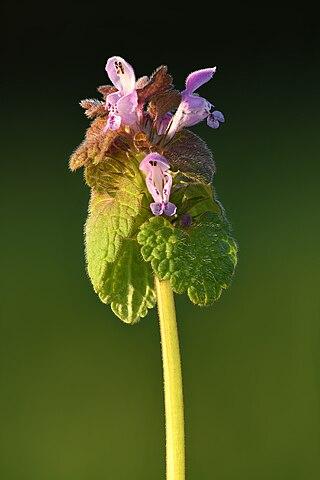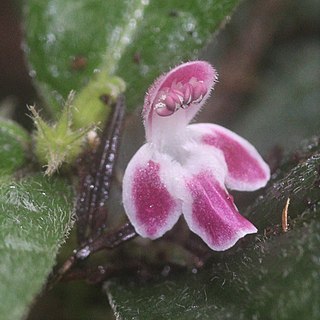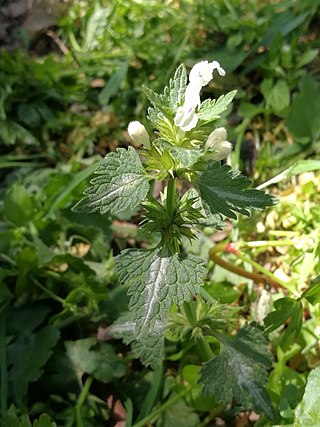
Lamium (dead-nettles) is a genus of about 30 species of flowering plants in the family Lamiaceae, of which it is the type genus. They are all herbaceous plants native to Europe, Asia, and northern Africa, but several have become very successful weeds of crop fields and are now widely naturalised across much of the temperate world.

Lamium purpureum, known as red dead-nettle, purple dead-nettle, or purple archangel, is an annual herbaceous flowering plant native to Europe and Asia but it can also be found in North America.

Lamium galeobdolon (gah-lay-OB-dough-lon), the yellow archangel, is a species of flowering plant in the mint family Lamiaceae. It is native to Europe and western Asia but it is widely introduced in North America and elsewhere. It is the only species in the genus Lamium with yellow flowers. Another common name for this species is golden dead-nettle. In New Zealand, it is called the aluminium plant or artillery plant. The common names archangel and dead-nettle have been in use for hundreds of years, dating back to at least the 16th century.

Lamium amplexicaule, commonly known as common henbit, or greater henbit, is a species of Lamium native to Europe, Asia and northern Africa.

Scheuchzeria palustris, is a flowering plant in the family Scheuchzeriaceae, in which there is only one species and Scheuchzeria is the only genus. In the APG II system it is placed in the order Alismatales of the monocots.

Lamium album, commonly called white nettle or white dead-nettle, is a flowering plant in the family Lamiaceae. It is native throughout Europe and Asia, growing in a variety of habitats from open grassland to woodland, generally on moist, fertile soils.

Lamium maculatum is a species of flowering plant in the family Lamiaceae, native throughout Europe and temperate Asia.

Brillantaisia is a genus of plants in the family Acanthaceae. They are native to the African tropics and subtropics, including Madagascar. They may grow from 20 cm to 2 m in height. Their hirsute stems are square in cross-section and their heart-shaped leaves have an opposite arrangement. Their purple or white pea-like flowers produce long, cigar-shaped seed pods. They reproduce easily from seeds or vegetatively. One species, B. lamium, is invasive in Queensland.

Dolycoris baccarum, the sloe bug or hairy shieldbug, is a species of shield bug in the family Pentatomidae.

Macdunnoughia confusa, or Dewick’s plusia, is a moth of the family Noctuidae. It was first described by James Francis Stephens in 1850. It is found from Europe through Siberia to Japan and is also present in Lebanon and Israel.

Diachrysia chrysitis, the burnished brass, is a species of moth of the family Noctuidae. It is found in Europe, the Caucasus, Russia, Russian Far East and Siberia. In the south of Europe the range extends to southern Spain, southern Italy and the Balkan peninsula. It is lacking on most of the Greek Islands. In the north it extends into almost to the Arctic circle and far north Russia. In the east the range extends to the Amur region and Japan.

Polymixis polymita is a moth of the family Noctuidae. It is found in most of Europe, but not in the Benelux, Britain, Ireland and the Iberian Peninsula.

Agrochola litura, the brown-spot pinion, is a moth of the family Noctuidae. The species was first described by Carl Linnaeus in 1761. It is found in Europe and the Middle East. It is possibly also present in North Africa, but this is unclear because similar looking species Agrochola meridionalis is found there.
Coleophora ballotella is a moth of the family Coleophoridae. It is found from Germany, Poland and the Baltic States to the Iberian Peninsula, Italy and Greece. It has also been recorded from northern and southern Russia.

Coleophora lineolea is a moth of the family Coleophoridae. It is found in most of Europe.

Coleophora ochripennella is a species of moth from the family Coleophoridae. It is found from Germany and Poland to the Pyrenees, Italy and Greece.

Ajugoides is a genus of plants in the family Lamiaceae, first described in 1915. It has only one known species, Ajugoides humilis, endemic to Japan. It has been reported from the islands of Honshu, Shikoku, and Kyushu.

Eriopygodes imbecilla, the Silurian, is a moth of the family Noctuidae first described by Johan Christian Fabricius in 1794.

Lamium bifidum is a species of flowering plant in the mint family Lamiaceae, native to the Southern Europe. It was first described by botanist Domenico Cirillo in 1788.
















